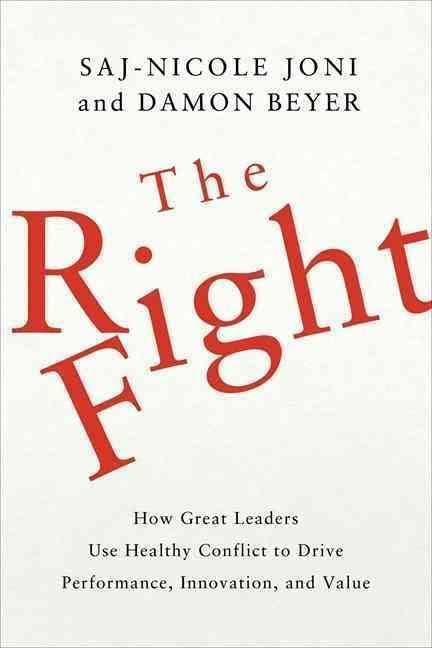Language English Publication date February 2010 ISBN 978-0-06-171716-1 Subject Management | Pages 234 pp Originally published February 2010 Country United States of America | |
 | ||
Leadership books The Third Opinion: How Suc, Leading Outside the Lines: Ho, Leadership Principles for Projec, Savage Coast: Leadersh, Leadership and the new scie | ||
The Right Fight is a 2010 book about business leadership. The authors argue that leader's time is not always best spent trying to help people in teams work in peaceable alignment. In contrast, Joni and Beyer show that leaders who foster productive dissent—what the authors call "right fights"—help their companies reach peak efficiency. The book ranked #6 on 800CEOread.com’s Books to Watch List in March 2010 and ranked #21 on its Bestseller list in October 2010.
Contents
- The right fight
- Part One Alignment and Tension in Organizational Life
- Part Two Learn to Pick the Right Fights The Right Fight Decision Principles
- Part Three Learn to Fight Right Fights Right The Right Fight Discipline Principles
- Part Four Tools Tests for Identifying and Leading Right Fights
- Principles
- Companies
- Response
- References
The right fight
Part One: Alignment and Tension in Organizational Life
Leaders must introduce and manage right fights to create breakthrough performance, meaningful innovation, and lasting value
Chapter One - Alignment is Not the Whole AnswerResearch demonstrates that tension is required for performance. Right fights can help leaders use tension for maximum benefitsChapter Two - Three kinds of Fights Not Worth FightingThere are all kinds of wrong fights. Decoding them is the first step to stopping or avoiding them.Chapter Three - “Jack Sparr” Takes on a Right FightAn example of a right fight fought right.Part Two: Learn to Pick the Right Fights: The Right Fight Decision Principles
Chapter Four - Right Fight Principle #1 - Make it MaterialMake it about something worthwhile, something that matters.Chapter Five - Right Fight Principle #2 - Focus on the Future, Not the PastMove beyond blame to possibilities.Chapter Six - Right Fight Principle #3 - Pursue a Noble PurposePeople need to commit their integrity and passion to something bigger than the bottom line.Part Three: Learn to Fight Right Fights Right: The Right Fight Discipline Principles
Chapter Seven - Right Fight Principle #4 - Make it Sport, Not WarHave rules and play by them.Chapter Eight - Right Fight Principle #5 - Structure Formally but Work InformallySet up the fight in your organizational structure, but work out the tensions through informal networks.Chapter Nine - Right Fight Principle #6 - Turn Pain into GainPeople matter – everybody should grow in a right fight, even if they don’t win.Chapter Ten - ConclusionAll successful organizations fight right fights. When you can manage the tensions consciously, and use the Right Fight Principles as your guide, you and your teams will reap extraordinary rewards.Part Four: Tools: Tests for Identifying and Leading Right Fights
Chapter Eleven - Is the Challenge Worth a Right Fight?Assessment ToolAcknowledgementsIndexPrinciples
This book shows how leaders can foster healthy dissent in order to achieve high performance, foster innovation and groom the next generation of leaders. Done well, right fights bring out the best of human capacity. By contrast, wrong fights – or right fights that never happen – can transform high purpose into failure.
The first three right fight principles described in Part Two guide readers in recognizing right fights. These principles are:
- make the fight material, with big enough stakes to motivate everyone
- focus on the future, without apportioning blame for the past
- make the fight about a noble purpose – such as improving the lives of customers
The last three right fight principles, covered in Part Three, are:
- make the fight a sport with rules, rather than a war
- Structure right fights through the formal organization, but create informal networks and coalitions to help good ideas triumph in spite of the hierarchy
- Turn pain into gain by assuring that everyone, including the losers, benefits from the experience.
Companies
Joni and Beyer include several case-study examples of leaders engaged in “right fights” in the following companies:
Response
Publishers Weekly noted that “Joni and Beyer make a convincing and counterintuitive argument that instigating dissent, if done selectively, can produce big results.”
Booklist observed that the authors “present valuable, thought-provoking ideas and conclude with an assessment tool for determining if an issue is an appropriate candidate for a right fight.”
Warren Bennis, Distinguished Professor of Business, University of Southern California and author of On Becoming a Leader remarked that “Anybody in any organization who has any responsibility must read this book.”
Marshall Goldsmith, the NYT bestselling author of Succession: Are You Ready? and What Got You Here Won't Get You There noted that “Managing tension and conflicting ideas is but part of the equation. Using them to steer the organization toward success is the other part, which is often overlooked. In The Right Fight, Saj-Nicole Joni and Damon Beyer show us how to use conflict the right way!”
Doug Stone, coauthor of NYT bestseller Difficult Conversations: How to Discuss what Matters Most, observed that “The wisdom runs deep and the stories jump off the page. Joni and Beyer show us why alignment is not enough. Fighting the right fights right can be the difference between survival and extinction. This book should be at the top of any leaders reading list.”
